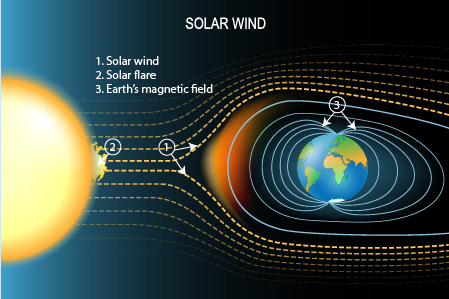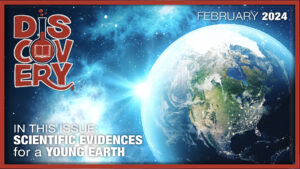Scientific Evidences for a Young Earth
Scientific Evidences for a Young Earth
The Bible tells us that the Earth is only a few thousand years old, and there are definitely scientific evidences that support the Bible’s teaching on the subject.

We have to keep in mind that many things will appear to be old because God had to create the Earth in such a way that it would be fit for humans to live on it when they were created on the sixth day of Creation week. The Earth, therefore looked “mature” from the moment it was created. That said, there are still many scientific evidences which support what the Bible teaches about the age of the Earth. Here are eight examples (among many that could be given) that, even when using the old Earth assumption of uniformitarianism (the idea that whatever is happening today in geology—like how fast a canyon is eroding—must have always happened that way throughout history), support a young Earth and Universe:
1. Carbon-14 in “Ancient” Fossils and Materials:
In chemistry we learn that some materials in rocks (“parent” isotopes) change (“decay”) into other materials (“daughter” isotopes) over time. Organic materials (materials that were once alive, like bone or wood) have Carbon-14 (C-14) in them which decays into Nitrogen-14 (N-14). Scientists are able to measure how fast that break down happens today. They know that at today’s rate (that is, half of the original C-14 breaks down to N-14 in 5,730 years—the half-life of C-14), they should not be able to detect C-14 in any organic material thought to be 100,000 years old.But C-14 has been found in fossilized wood, dinosaur fossils, ammonite shells, reptiles, and sponges that evolutionists believe are tens, and even hundreds, of millions of years old in some cases. Coal and diamonds have also been found with C-14 in them, even though they are believed by many geologists to be millions and even billions of years old, as in the case of diamonds. 1If C-14 is still found in organic materials, the materials cannot be millions or billions of years old.



2. Tightly Folded Rock Strata:
Secular geologists believe that the rock layers of the Earth are formed from millions of years of dirt, sand, and materials gradually building up and turning to stone. If that was true, the rock layers below the surface should have been “brittle” as the surface was being built up, like the rock layers below the surface today. When the plates of the Earth’s crust moved, the rock layers should have cracked and broken, rather than bent—since rocks do not bend, but break. In many places on the Earth (like the Grand Canyon and Karijini National Park in Australia), however, rock layers can be seen that are bent and folded in major angles without fracture. Rather than being millions of years old, it makes more sense that materials in the rock layers were deposited quickly during the Flood. Then, while the layers were still somewhat soft, before they had lithified, fast plate movement caused the layers to bend.
3. Human Population Statistics:

Scientists who study human population estimate world populations in the past based on statistical equations that account for factors such as war, disease, and famine. If humans2 have been on the Earth for one million years, there should be 102,000 people on the planet—enough humans to pack the entire Universe with humans like sardines many times over. If humans have been around two to three million years (as evolutionists argue), the problem only grows. If the young biblical timeframe is correct, however, there should be between 6.7 and 8.1 billion people on the planet today3—exactly what the human population is according to the U.S. Census Bureau.
4. Build-Up of Sea Floor Sediment:
Each year, material on the ocean floor builds up as wind and water sweep material from the continents into the sea. Some of that material is removed as some of the Earth’s plates sink into the mantle, leaving about 19 billion tons of sediment being built up each year. If secular geologists are correct, and (a) the ocean is 3.8 billion years old and (b) geologic processes have remained constant throughout time (that is, uniformitarianism is true), then the ocean cannot be even 1% as old as secular geologists claim—it must be much younger. When the Flood is factored into the equation—keeping in mind how much material from the continents and from below the ocean floor was added to the ocean—we realize the age of the ocean must be even younger still. Even local floods cause sediment build-up rates in the ocean to be multiplied several times over. (How much more the global Flood?)

5. The Decay of Earth’s Magnetic Field:

Earth has magnetic poles and a magnetic field that helps to protect us from the Sun’s radiation and solar winds. The magnetic field is getting weaker, though. Half of the Earth’s magnetic field intensity decays every 1,100 years. If that decay rate has remained constant from its beginning (as uniformitarian thinking would suggest), we find that the Earth could not be millions of years old, much less billions, as many geologists believe. Instead, the Earth must be only thousands of years old.
6. The Moon’s Recession Rate:

The Moon is gradually moving farther and farther away (receding) from the Earth. Using the equation that describes how fast the Moon is moving away, and assuming (like uniformitarian geologists) that the recession equation has been the same throughout time, we find that the Earth and Moon cannot be as old as many scientists claim (that is, over 4.5 billion years). The Moon would have been touching the Earth only 1.5 billion years ago. Either uniformitarianism is false (and therefore, all old Earth dating techniques are false, since they rely on uniformitarianism), and/or the Earth is much younger than many claim.
7. Helium in the Atmosphere:
Scientists know that helium is building up in the Earth’s atmosphere. They know how much helium is there and how fast it is building up, taking into account how much helium is being released into space. Based on the current rate of helium build up in the atmosphere, we know it could not be even two million years old, much less 4.5 billion years. If God created the atmosphere with helium already in it, and if extra helium was added to the atmosphere during the Flood (an idea supported by physical evidence), the atmosphere would be much younger still.
8. Young Spiral Galaxies:
Have you ever sprinkled cinnamon in a hot, foamy drink and then stirred it? You might have noticed the foam starts looking like a spiral pinwheel. If you looked closer, you might have noticed that the part spinning closer to the center was moving faster than the part along the edge of your cup.
Because of that movement (called “differential rotation”), it does not take long for the foam no longer to look like a spiral. The center turns into a blob. Many of the galaxies in the Universe are spiral galaxies that are also spinning. The problem is that if those galaxies are as old as evolutionists claim, they should no longer look like spirals. According to the evidence, they must be much younger than many astronomers believe.
There are many other examples that we could list that prove the Universe, including the Earth, cannot be as old as evolutionists believe, given their own assumptions. Each of these examples that we have listed shows that a young Earth is a scientifically valid idea.

REPRODUCTION & DISCLAIMERS: We are happy to grant permission for this article to be reproduced in part or in its entirety, as long as our stipulations are observed.









0 Comments:
Post a Comment
<< Home